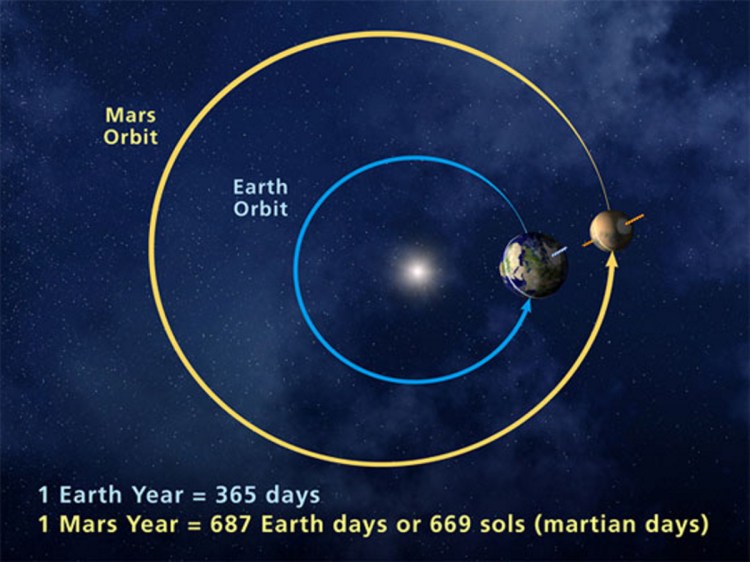If you’re wondering what that bright, slightly reddish light in the southeast is, around 10 p.m. lately, it’s Mars. You have to be a practiced stargazer to notice that it’s a dite dimmer (magnitude minus 2.5) than it was two weeks ago (magnitude minus 2.8). But overall this summer it’s nearly as bright as it ever gets, seen from here on Earth.
There are two reasons for this. One is that Mars is “at opposition,” as the astronomers say. It means that Mars is directly opposite the sun. Put another way, it means the Earth is more or less directly between the sun and Mars. So the sun’s light is traveling out to Mars and reflecting more or less straight back, rather than at an angle, showing us more light than usual.
The second reason Mars is so bright is because opposition is the moment when Mars is closest to Earth in its orbit of the sun. This summer it’s even closer than usual, about 35.8 million miles. The Earth circles the sun once a year (obviously) between the sun and Mars. Mars takes about two Earth-years to orbit the sun, so once every two years Earth is right between the sun and Mars, setting up the opposition.
The two orbits are not exactly concentric. The Earth traces out a fairly round ellipse, while Mars traces a flatter ellipse. This means Mars passes closer to the sun at one end of the elliptical orbit and farther away from the sun at the other end. Every 15 to 17 years, the Earth passes between Mars and the sun at the closer end of Mars’s ellipse, when the distance from the sun to Mars is the smallest, and so the distance between the two planets is smaller too. When the distance to Mars is smaller, Earth picks up more reflected light and Mars looks brighter than it does when it’s farther away. That’s what’s happened this summer, as Mars will reach its perihelion, or closest approach to the sun, on Sept. 16.
The last time the Earth passed this close to Mars was Aug. 28, 2003, when we were actually closer at 34.65 million miles. That was the closest approach of Mars to Earth in the last 60,000 years, when the two planets were 34.62 million miles apart. The next unusually close encounter will occur on Sept. 15, 2035. The most distant Mars has been during a recent opposition was 62.6 million miles in March 2012.
A couple of other interesting things about Mars this summer. One is that a huge dust storm has been raging over basically the entire planet since the end of May. It started in the usual way, when a series of funnel clouds, similar to dust devils (which are not uncommon on Mars’s surface), created dust lifting centers in Mars’s northern hemisphere and intensified into a storm. Over the next couple of weeks the storm grew massive and by mid-June had become a “planetary-encircling dust event.” The Opportunity rover near the martian equator went into low power mode, basically shutting down, unable to charge its batteries from solar power because of the dust-darkened sky.
The storm is winding down at this point, but the planetary geologists are not sure how much longer it will last. The last big, planetwide dust storm on Mars happened in 2007.
The other Martian news is that it looks, according to a recent study, as though there is almost certainly a lake of liquid water underneath an area near Mars’ south pole. A radar instrument aboard the Mars Express spacecraft detected a bright patch about a mile deep and 12 miles wide that can only be explained viably by the presence of liquid water. The temperature in the area is around minus 90 degrees Fahrenheit, but similar studies in Antarctica (on Earth) have shown that subterranean lakes of liquid water can exist at temperature far below freezing when there are salts in the water to lower the freezing point. (The freezing point of ocean water, for example, is about 28 degrees.) Sodium, magnesium and calcium salts are plentiful on Mars, and the researchers are pretty confident of their conclusion.
This is significant because the evidence that liquid water exists on Mars has been mounting for years. And since Mars in its deep past definitely had large oceans, where life could conceivably have arisen, then any liquid water present there now could mean living beings (probably microbial) exist. Stay tuned. Some scientists think the discovery of extraterrestrial life forms is going to take place any time now.
Think about it, when you look up and spot Mars shining there these warm summer evenings.
Dana Wilde lives in Troy. You can contact him at naturalist1@dwildepress.net. His recent book is “Summer to Fall: Notes and Numina from the Maine Woods” <http://www.northcountrypress.com/summer-to-fall.html> available from North Country Press. Backyard Naturalist appears the second and fourth Thursdays each month.
Send questions/comments to the editors.



Comments are no longer available on this story